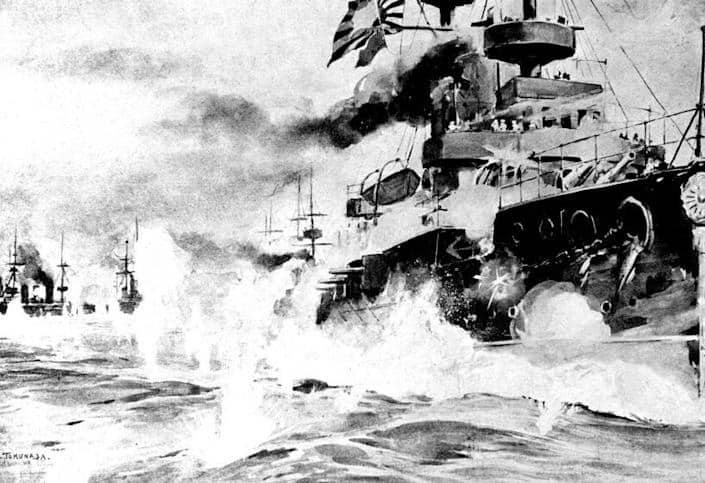
On TV and online, commentators furiously seek comparisons to past conflicts for insights into the Ukraine-Russia war. How will it ever end?
At the same time, military analysts are closely watching how lethal new technologies are leading to appalling carnage like that in Donbas and Irpin. What can we learn about how to fight future wars?
The surprising answers spring from comparisons to an oft-overlooked conflict more than a century ago, between a small nation barely elbowing its way onto the world stage and a huge but faltering Western power that turned out to be Russia.
The Russo-Japanese War of 1904-05 was a big deal at the time, and is generally considered the first modern war. The world watched with rapt attention. In the history of this conflict, we can find clues about what is happening, and what may yet happen, in Vladimir Putin’s ill-conceived and bloody invasion of Ukraine.
Repeating rifles, machine guns, and rapid-fire artillery were as new in 1904 as Javelin anti-tank missiles and Turkish drones are today. They all played a role, as did the rapidly maneuvering steel warships. The destruction by the Japanese navy of the Russian Baltic fleet, which had sailed to the other side of the planet, shocked the world in 1905 as much as the sinking of the Russian cruiser Moskva by Ukrainian missiles did this month.
But he shouldn’t have. And the struggles of the Russian military today would not surprise anyone who has studied the Russo-Japanese war either. Rivers of similarities run through these two conflicts.
Naturally, there were differences, the biggest of which was that Japan, angered by diplomatic betrayals and Russian expansion in Asia, went to war. It began with a surprise night attack by a torpedo boat against the Russian fleet at Port Arthur (now the Lüshunkou District of China).
The Japanese Navy was modern, its traditions were based on the Royal Navy of Great Britain; Japanese sailors even ate curries on Fridays like their English counterparts. (They still do it.) Their warships were state of the art and built in England. Thus, a major Western power supplied modern technologies to the smallest of warring nations, as in the current conflict.
Japanese soldiers and sailors, swept up in their nation’s extraordinary shift toward modernity, were motivated to fight. They were also trained and fed well. And they saw Russia as a greedy and overreaching bully.
Meanwhile, Russian soldiers quickly found themselves under siege in the arid winter landscape of Port Arthur, thousands of miles from Russia’s major urban centers, and with no real reason in their heads why they were fighting. Supply lines, already extraordinarily long, were easily severed. Equipment, training and basic supplies were missing from the Russian soldiers.
Sounds familiar?
The world was sure that Russia would win. She had a boasted army in the great European tradition. How can little upstart Japan come out on top?
Like the conflict in Ukraine that was streamed live to and from smartphones, the Russo-Japanese war was watched around the world in near real time. Telegraph wires and steam-powered newspaper presses sent new editions into the streets every hour to feed a hungry public.
The Japanese bottled up the Russian Pacific squadron at Port Arthur, so the Russian Emperor Nicholas II, always confident of victory, despite setback after setback, changed tactics and sent his huge Baltic Fleet on a trip around the world to teach emerging Japanese. a lesson.
They toured Africa beset by logistical and maintenance problems. The ships were outdated and poorly maintained, crew training was minimal. So incompetent were the captains that, while off the coast of England, they opened fire on British fishing boats, believing them to be Japanese attackers. Repairs were paid. It reminds one of the seemingly ungoverned Russian forces bumbling through Ukraine.
Finally, after seven months, the Russian fleet reached the Far East. Alerted by telegraph from the island of Tsushima, the Japanese Admiral, Heihachirō Tōgō, set sail with his fleet fresh and eager to meet the exhausted Russians. Within hours, virtually every Russian battleship was at the bottom of the sea.
Tōgō and his command staff conducted the battle from the open-air bridge atop his flagship, the Mikasa. The Russian admiral, by comparison, remained huddled inside the closed steel wheelhouse of his ship. Thus, Tōgō had a 360-degree view of everything that was going on and, perhaps more importantly, his crews could see him, in the open, watching everything through binoculars as shells whizzed by.
Not unlike the stubbornly visible leadership of Ukrainian President Volodymyr Zelensky today.
The two countries soon had a negotiated peace. Japan had become a world power.
The legacy of that war was lasting and not necessarily positive. It presaged the horror of the battlefields of the First World War. Anger at defeat was one of the reasons the Russian people finally rose up against Nicholas II in the revolution. In Japan, the overconfidence of this conflict led military leaders to believe that the Western powers were empty, unwilling to fight, and could be defeated with surprise, brains, and guts. This brought us to Pearl Harbor.
The world’s expert military took to heart the lessons on trench building, frontal attacks, and the power of a well-maintained, well-trained, well-trained battleship squadron armed with heavy turreted guns and smokeless powder. , just as today’s viewers are wrestling with the deadly lessons of those Javelins, drones, and Neptune anti-ship missiles.
There is still pride in Japan for the victory in Tsushima. The Mikasa is now a museum in Yokosuka, near Tokyo. You can visit Tōgō’s hut and admire his bathtub. Perhaps one day we will be able to admire Zelensky’s bathtub in kyiv.
Wendell Jamieson is a regular contributor to Military History Quarterly.
This story originally appeared on Los Angeles Times.
Reference-news.yahoo.com